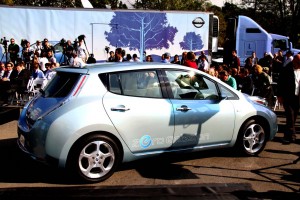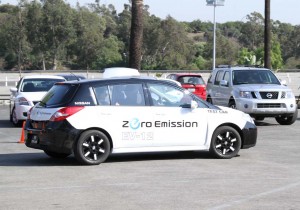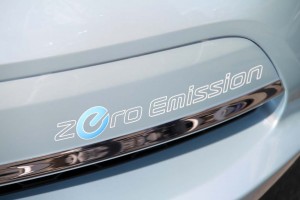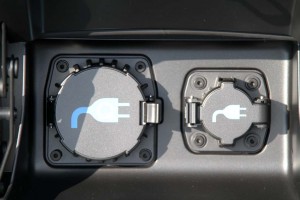
Nissan rolls out a prototype of the 2011 Leaf battery-electric vehicle to launch its 22-city "Zero Emissions Tour," before next year's introduction.
Every so often, the fate of an automaker winds up riding on a single new product. For Nissan, the new Leaf could be exactly one of those vehicles.
No, if the little 5-seat sedan, set to roll into showrooms next year, fails to attract enough buyers, the Japanese automaker won’t go broke. But Nissan’s corporate pride and image clearly have been wed to the success of the battery-electric vehicle, or BEV.
Long the also-ran in terms of bringing environmentally-friendly products to market, Nissan hopes to leapfrog leaders like Toyota and Honda, who it contends are taking only halfway measures, focusing on hybrid gasoline-electric vehicles that continue to burn petroleum and produce global warming emissions. Nissan is going all the way, with Leaf – and three other BEVs it’s developing – which will eliminate tailpipe emissions entirely.
While “electrification” has become an industry buzzword, Nissan’s faith in battery technology puts it far out on a limb, with Leaf. So, we jumped at a chance to take the new electric sedan for a spin – in this case, a moderately short one around a special course set up next to Dodge Stadium, in Los Angeles, where the Japanese maker is kicking off a 22-city “Zero Emission Tour” that will lead up to next year’s formal introduction.

Nissan provided a chance to drive the new Leaf battery car's drivetrain and platform, but used a "mule" with a Versa body.
Leaf, proclaimed Nissan’s CEO Carlos Ghosn, “will change the industry,” indeed, the world, he insisted during a presentation leading up to the drive. There are a lot of details left to be revealed about the little sedan, like price, though Ghosn stressed the vehicle “will be affordable,” and should come in within “one or two percent” of a conventional, gasoline-powered compact sedan.
This would suggest something around $25,000, though whatever the final figure, it won’t include the Lithium-Ion battery pack, which will be leased separately. That’s the single most expensive part of a BEV, so Nissan’s plan is to shift thinking, to make consumers see the battery as part of their monthly transportation energy bill.
Again, Nissan isn’t providing figures, but the company has suggested it will set the final lease price based on a typical motorist driving about 1,200 miles a month. Depending on what the assumption for gas prices you use, in a vehicle of this size, that could work out to somewhere between $180 and $250 a month. The actual electric bill, as little as a penny or two a mile, would add somewhere between $12 and $25 a month, at least if a driver charges Leaf up overnight when energy costs – using an interruptible service plan – are lowest.
Though Nissan had an actual Leaf prototype on display, at Dodgers Stadium, the car we got to drive was a “mule,” the latest engineering prototype, with the body of a similarly-sized Nissan Versa, but all the mechanicals of the actual Leaf, so the driving experience was as close as possible to what the BEV would be like if it were in production today.
That means about 80 kilowatts of power, roughly 110 horsepower, enough to launch from 0 to 60 in “less than 10 seconds,” suggested Ghson, with a top speed of 90 mph and a range of 100 miles – less if you’ve got your foot flat to the floor.
In some ways, those numbers didn’t do the Leaf mule justice. One of the most appealing features of battery propulsion is the fact that electric motors generate maximum torque the moment they start turning, something the start-up, Tesla Motors, is using to full advantage with its Roadster sports car. Stomp on the throttle, and even the less aggressive Leaf shoots forward like a shot, sinking you deep into your seat.
What’s odd is the near-complete silence in which it takes off. There’s never much more than a gentle whine when the sedan is moving, and at higher speeds all you hear are wind and tire noise.
As currently set up, the throttle felt a bit more like an on-off switch than a conventional vehicle’s accelerator pedal. That’s something that engineers are working on to resolve before production begins, acknowledged Hideaki Watanabe, general manager of Nissan’s new EV unit. On the positive side, there was none of that sudden lurching when you let up on the Leaf’s throttle. Nissan engineers decided not to deal in too much of what’s known as regenerative braking. Here it felt much like the engine braking you might experience backing off on the throttle of a compact car with an inline-four gasoline engine.
With braking, Nissan needs to do a bit more work, as well. Again, the feeling is a bit notchy. Here’s where there’s a lot of regenerative braking, a technique by which energy that would normally be lost is recaptured and send back to the batteries as electric power. Regen comes on hard as soon as you just tap the brakes. The feeling needs to be more linear, even if it costs a couple miles of range.

Environmental "guilt" will drive some customers to go for an EV, but battery cars must be competitive with conventional vehicles to truly catch on, cautioned Nissan CEO Carlos Ghosn.
Steering feels comparable to the Versa, which is an acceptable small car but you certainly wouldn’t confuse it with a sports car. We took the few opportunities presented to us to throw the car into a corner hard and the Leaf suspension of the mule was surprisingly stable, a good indication that Nissan doesn’t plan to settle for the soft and sloppy sort of ride that we suffer through with the Toyota Prius hybrid.
We’re certainly looking forward to getting more time behind the wheel of the 2011 Nissan Leaf, preferably a production vehicle, and we’ll certainly update this review as soon as we get that opportunity. But based on our brief but intriguing drive we think the new Leaf could live up to Ghosn’s promise that the new BEV will be more than just a car to assuage your environmental “guilt.” That maeans something cool, attractive and fun-to-drive.


